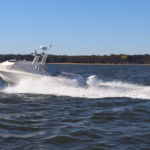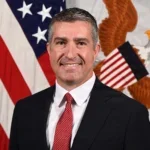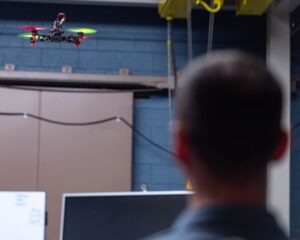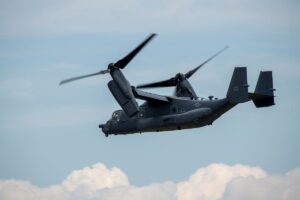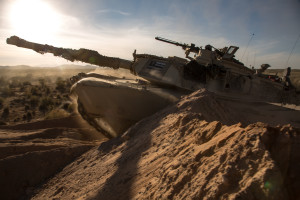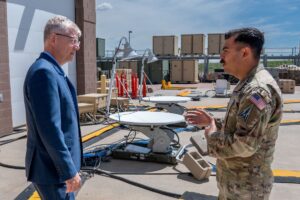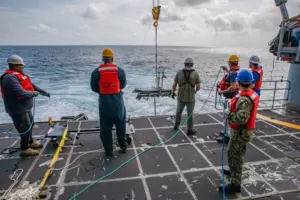
INDUSTRY PERSPECTIVE – Barbara Supplee, Executive Vice President, Navy Business, SAIC
The U.S. Navy has long stood as a formidable force beneath the waves, but as technology transforms the nature of undersea warfare, so too must the tools and technologies at the Navy’s disposal to deal with those challenges. Leveraging and fielding cutting-edge and emerging technology is critical to the Navy’s operational design as it looks to augment – not replace – the fleet with unmanned underwater vehicles (UUVs) to retain its asymmetric undersea advantages now and into the future.
With bespoke systems and lengthy, cumbersome acquisition processes the Navy, and DoD writ large, face uphill challenges in procuring and employing technologies at the speed and scale requirements from future conflicts point to. Similar challenges exist in the defense tech sector as it navigates those processes while also managing fiscal and supply-chain challenges as it researches and develops innovative commercial and dual-use technologies.
Key to any successful capability development depends on leveraging a large network of partners and ventures to bring cutting-edge emerging technology to the Navy via an ecosystem that includes academia, industry leaders, and startups, each bringing unique expertise and perspectives. By fostering collaborations between them, the Navy can tap into a pipeline of technology innovators, pioneering research, and emerging technologies to ensure the Fleet stays at the forefront of scientific and technological advancements through state-of-the-art solutions development.
Innovation in Action
As a mission integrator focused on outcomes, SAIC excels in synthesizing existing systems, emerging technologies and best-in-class commercial solutions into cohesive and effective solutions oriented toward the warfighter. We bring together our experience, expertise and ecosystem – to include partners and ventures – to drive mission critical, operable solutions to the Navy rapidly, securely and at speed. A highlight of this will be our participation in an upcoming major international exercise this summer, working alongside VATN, a defense startup that builds affordable underwater vehicles at an unprecedented scale, and Invisible, a commercial AI partner, to test a UUV network in an operational environment.
In future maritime operations the Navy will need to field agile, scalable counter-UUV capabilities that can operate independently or as part of a larger force structure. With our partners and the future in mind, SAIC is testing a collaborative UUV group that can be trained to operate as an integrated layer within the Navy’s existing undersea warfare (USW) architecture.
Starting with a robust command and control system using adaptive AI to minimize communication needs, our team is developing a multi-mission intelligent solution that enables UUV autonomous maneuvers to provide undersea decoy, diversion, and surveillance. Coupled with other systems, this also provides a key real-time counter-UUV solution that is both cost-effective and agile and enhances command and control and Fleet protection.
The autonomous command and control system SAIC is investing in for the Navy is designed to either operate independently as separate force structure or seamlessly operate within the Navy’s existing infrastructure to ensure new technologies enhance – rather than disrupt – Fleet design. Using modeling and simulation and AI/ML to reduce time from sensor package/platform
concept to live operations, we have created group level unmanned systems behaviors and connected those edge assets into integrated battle space environments to allow group level control.
Additionally, advancements in technology and communications media allow UUVs to be elevated into the Naval Link architecture with simple capability additions like SAIC’s Joint Range Extension (JRE). Naval combatants are currently adding JRE capability and utilizing installed communications, as well as STARSHIELD, to allow the Undersea Warfare Commander remote access to tailor platform configurations and operations while advancing situational awareness. While fielded throughout the DoD and Allied/NATO countries today, the possibility for these capabilities extends to containers, virtual machines, or on small processors such as Raspberry PI, which extends awareness horizons to improve decision making advantages.
Sustaining and Improving Undersea Dominance
Autonomous command and control UUVs are more than just advanced technology; they are a strategic enabler for the Navy’s undersea dominance. Soon, these autonomous UUV groups will be able to provide persistent underwater surveillance, threat neutralization, and cueing support to manned platforms such as submarines, destroyers, and maritime patrol aircraft, and act as both an early-warning sensor grid and a rapid response mechanism when needed.
Our commitment, alongside our partners, is on continuous improvement to ensure these capabilities evolve in response to emerging threats and operational requirements as, and when, needed. By maintaining an iterative development process and close collaboration with the Navy, we can ensure our UUV solutions remain responsive to the dynamic undersea warfare environment and that the Navy remains a dominant force beneath the waves.

Are you a Defense Daily reader with a thought-provoking opinion on a defense issue? We want to hear from you.
- We welcome submissions of opinion articles on national security, defense spending, weapons systems and related areas.
- We welcome submissions from lawmakers, administration officials, industry representatives, military officials, academics, think tank experts, congressional candidates, international experts and others on issues important to the national defense community.
- We welcome a diverse range of opinions all along the political spectrum.
- Email: editor@DefenseOpinion.com


